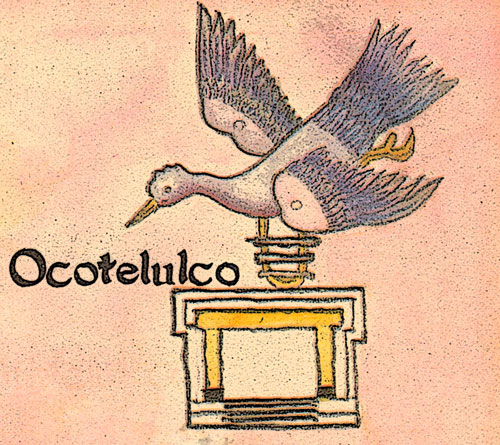Ocotelolco (Altepetl) on:
[Wikipedia]
[Google]
[Amazon]
 Ocotelolco (sometimes spelled Ocotelulco), in pre-Columbian
Ocotelolco (sometimes spelled Ocotelulco), in pre-Columbian
"Xicotencatl: rethinking an indigenous Mexican hero"
Estudios de Cultura Nahuatl, UNAM (Estudios de Cultura Nahuatl). *Muñoz Camargo, Diego (1892 (1585)
published and annotated by Alfredo Chavero, Mexico. *Fargher, Lane F. (2007
In the Shadow of Popocatepetl: Archaeological Survey and Mapping at Tlaxcala, México.
FAMSI.
 Ocotelolco (sometimes spelled Ocotelulco), in pre-Columbian
Ocotelolco (sometimes spelled Ocotelulco), in pre-Columbian Mexico
Mexico, officially the United Mexican States, is a country in North America. It is the northernmost country in Latin America, and borders the United States to the north, and Guatemala and Belize to the southeast; while having maritime boundar ...
, was one of the four independent altepetl
The ( , plural ''altepeme'' or ''altepemeh'') was the local, ethnically-based political entity, usually translated into English as "city-state", of pre-Columbian Nahuatl-speaking societiesSmith 1997 p. 37 in the Americas. The ''altepetl'' was ...
(polities) that constituted the confederation of Tlaxcallan
Tlaxcala ( , 'place of maize tortillas') was a pre-Columbian city and state in central Mexico.
During the Spanish conquest of the Aztec Empire, the Tlaxcaltecs allied with the Spanish Empire against their hated enemies, the Aztecs, supplying a ...
. The site is in the present day state of Tlaxcala
Tlaxcala, officially the Free and Sovereign State of Tlaxcala, is one of the 32 federal entities that comprise the Political divisions of Mexico, Federal Entities of Mexico. It is divided into Municipalities of Tlaxcala, 60 municipalities and t ...
in central Mexico
Mexico, officially the United Mexican States, is a country in North America. It is the northernmost country in Latin America, and borders the United States to the north, and Guatemala and Belize to the southeast; while having maritime boundar ...
.
History
Ocotelolco was the second of the four altepetl to be founded. At the time of theSpanish conquest of Mexico
The Spanish conquest of the Aztec Empire was a pivotal event in the history of the Americas, marked by the collision of the Aztec Triple Alliance and the Spanish Empire. Taking place between 1519 and 1521, this event saw the Spanish conquistad ...
it was, along with Tizatlan
Tizatlan, in pre-Columbian Mexico, was one of the four independent altepemeh (polities, sing. altepetl) that constituted the confederation of Tlaxcallan. Today Tizatlan is a part of the modern city of Tlaxcala, and the Pre-Columbian city is vi ...
, the most powerful of the four allied communities. Where Ocotelolco held the economical power, having the main market in the region, Tizatlan had the military power and commanded the Tlaxcallan armies.
When the Spanish arrived in Mexico Ocotelolco was ruled by Maxixcatzin
MaxixcatlThe Nahuatl name is often used in the honorific form as Maxixcatzin. was the tlatoani (ruler) of the Nahua altepetl (city-state) of Ocotelolco, one of the four towns that formed the state of Tlaxcallan. He was one of the main signers ...
. Through a series of political events Ocotelolco finally achieved dominance over Tizatlan at the end of the conquest.
Excavations
Excavations at the site in 1990-1991 carried out by the Instituto Nacional de Antropología (INAH) exposed a room with a painted altar and bench (47 cm high extending 8 meters along the room's north wall). The painted frieze closely resembles the Codex Borgia in style. The bench features a series of alternating skulls, human hearts, hands, and shields while eight anthropomorphic serpents descend on three sides of the altar, surrounding a central image of a deity (identified as Tezcatlipoca) surrounded by a frame of flint knives, similar in its composition to the image on plate 32 of the Codex Borgia.Elizabeth Boone. 2007.''Cycles of Time and Meaning in the Mexican Books of Fate.'' Austin: University of Texas Press. 222, fig. 132.References
*Hassig, Ross (2001"Xicotencatl: rethinking an indigenous Mexican hero"
Estudios de Cultura Nahuatl, UNAM (Estudios de Cultura Nahuatl). *Muñoz Camargo, Diego (1892 (1585)
published and annotated by Alfredo Chavero, Mexico. *Fargher, Lane F. (2007
In the Shadow of Popocatepetl: Archaeological Survey and Mapping at Tlaxcala, México.
FAMSI.
References
Altepetl Archaeological sites in Tlaxcala Mesoamerican sites {{mesoamerica-stub